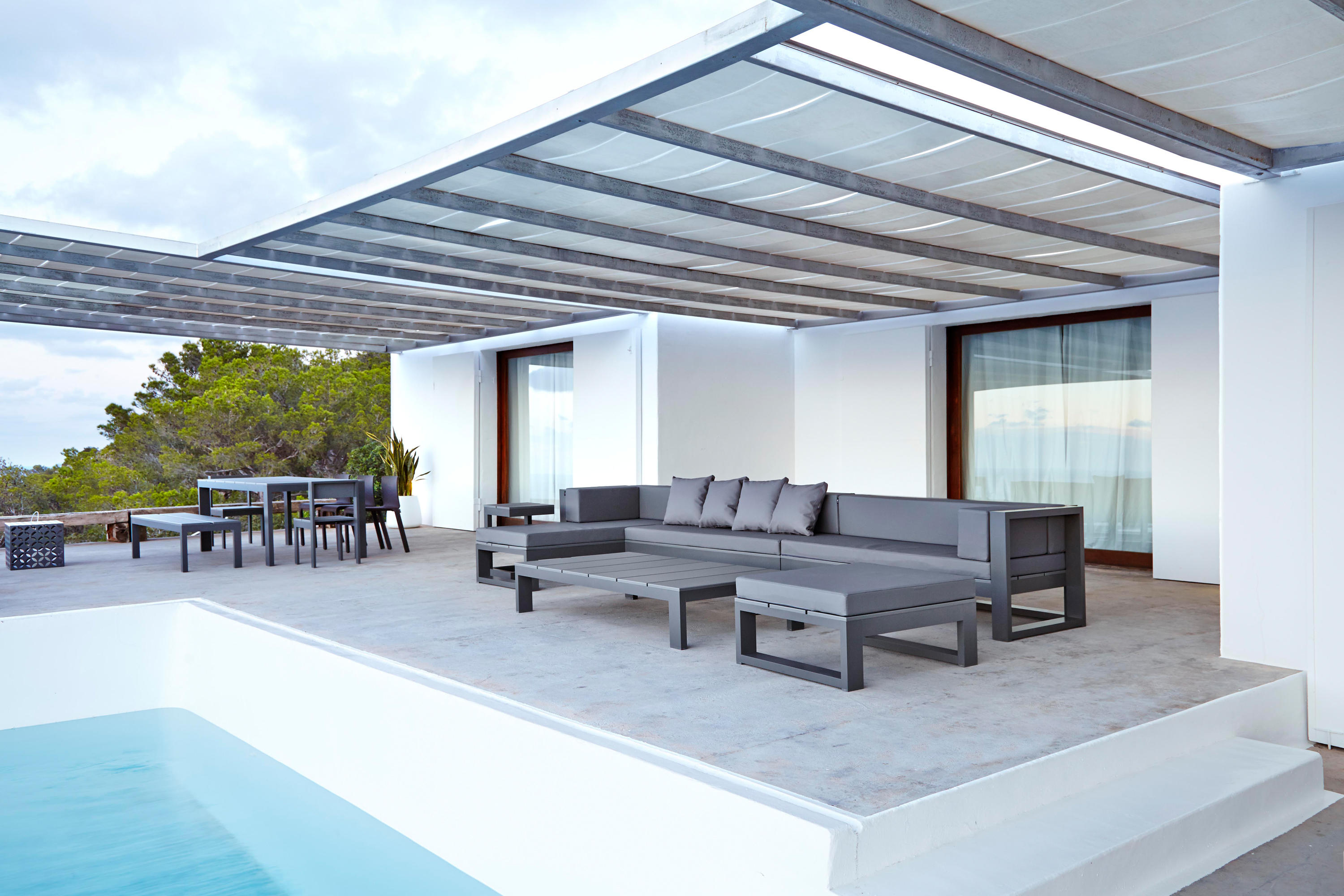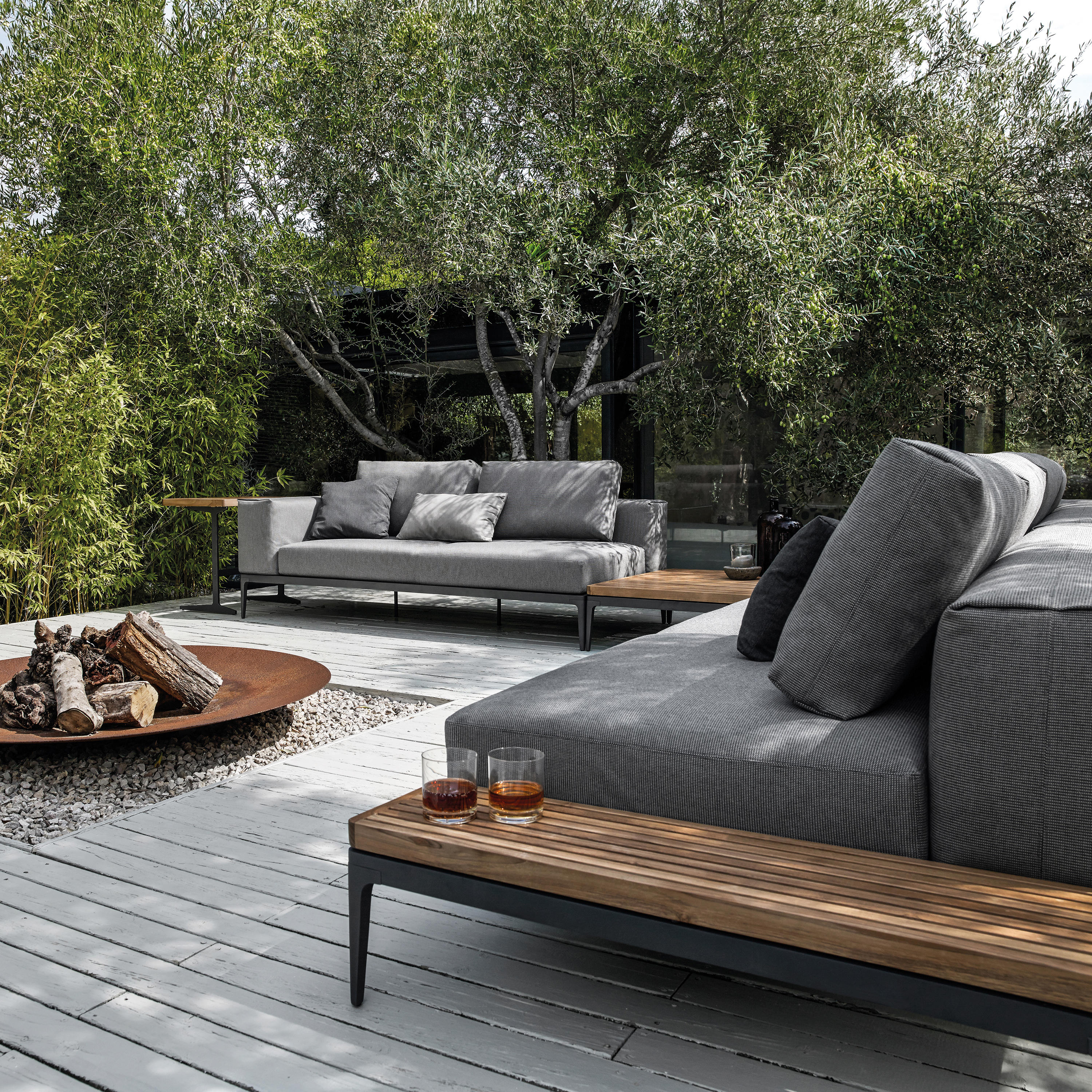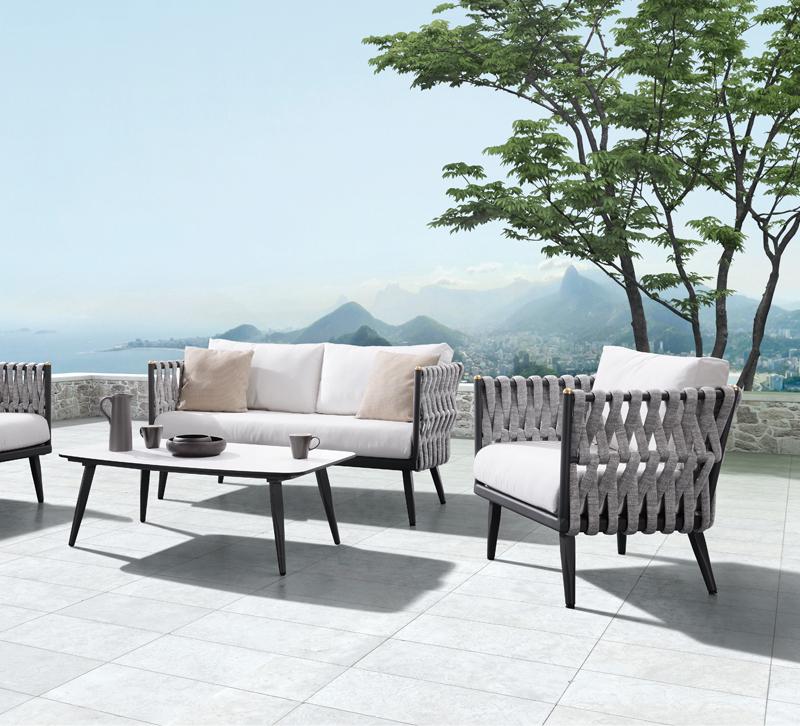As outdoor living continues to enjoy wild popularity among homeowners — from lush container gardens on a loft patio to expansive decks with vistas across swimming pools to outdoor kitchens for entertaining a crowd — interior designers are helping clients approach their natural spaces just as they would the rooms of their homes.
That task has been made easier in recent years as advances in materials that withstand sunlight without fading and are waterproof without sacrificing a soft, textural hand feel have helped blur the line between indoor and outdoor furnishings, flooring options and even window treatments. Patios and decks have become extensions of living rooms and kitchens for many mid-level houses, so luxurious outdoor living spaces are no longer the exclusive domain of high-end homes. Industry research indicates that comfort and sustainability are all emerging factors as consumers make choices for their outdoor furnishings. Homeowners’ wish lists include shade systems, fire pits and deep upholstered seating, highly durable rugs that help define spaces without walls.
In a 2017 report on the outdoor furniture industry, Irish research firm Research and Markets noted that U.S. consumers wanting more outdoor time to offset hectic work schedules and desk time, coupled with the popularity of staycations, have bolstered the boom in outdoor furnishings that are far beyond yesteryear’s aluminum folding chairs.
Interior designers whose clients ask for help on exterior spaces apply many of the same principles of indoor design to outdoor “rooms” and encourage clients to think of them in the same way for a seamless flow.
“First concept, then design”
Ligia Cisneros is the staff designer for Clima, a furnishings store with an emphasis on contemporary outdoor furniture in Miami’s Design District. She guides her clients to outdoor spaces that blend with their existing interiors by first assessing the space. “Some people have small balconies or narrow spaces with awkward layouts. Others have a very large space with few boundaries,” she says, following the mantra, “first concept, then design.”
Cisneros says clients are keen to work with professionals to create the area of their dreams. “They often show us pictures and landscaping plans to give us an overall idea of what we’re working with,” she explains.
For Cisneros, the key is then determining how clients plan to use the space. Will it be used for entertaining, exercise, family time, quiet reflection? Then the design work begins, keeping scale front of mind. “Outdoor work is different because interior space has walls, hallways, ceiling lines and other elements to define their spaces and usage .... outdoor spaces don’t have that,” Cisneros says. “So we think about scale, how landscaping works and how the space transitions from interior to exterior.” Finishes and design choices help make that transition smooth. “We really look at details,” she says, helping clients see how their exterior accessories can compliment how they have accessorized their homes. “There are so many options to make it your own little oasis,” Cisneros adds, noting lanterns add functional lighting, planters provide privacy and greenery, and umbrellas and canopies offer shade.
Cisneros advises clients on the benefit of having cohesive exterior and indoor spaces: “The outside is still part of your home. It still belongs to you, and your home should represent who you are,” she says. “Literally, you have another room, and it’s an extension of your home.”
Seamless Flow
Interior designer Jarret Yoshida splits his time between his office in Brooklyn, NY, Miami and Hawaii. His luxury design aesthetic is known for being relaxed and approachable. “I’m not interested in doing something contrived or hard to maintain,” he says. “You don’t want to be the mom who says, ‘Don’t sit on that’ or ‘Don’t eat there’ when kids come over. It takes away the fun in your life.”
Yoshida, a self-taught designer who began his career flipping houses in Long Island, NY, is a firm believer in the Japanese concept of shakkei. “Shakkei means ‘borrowed scenery’ or ‘borrowed view,’” he explains. “In design, it’s not outdoor versus indoor: It’s actually looking at both at the same time and integrating them in a seamless fashion. You have to consider your home as an entire entity. Think about it like your body. You’re not caring for your body and thinking about the outside versus the inside.” This holistic approach to a home’s full living space is informed by Yoshida’s upbringing in Hawaii, where warm outdoor living is enjoyed year round.

With the shakkei approach, Yoshida takes a deep dive into the details. “When you are designing a home that is fortunate enough to have an outdoor space, consider the relationship of the materials. For example, indoor flooring that can go outdoors: Can it be slip resistant when it gets wet? Do you want a subtle contrast or dramatic? Will the exterior portion be covered or exposed to the elements? All of these considerations are just for floor material choices!” he says with a laugh.
With his trademark quick-fire enthusiasm, Yoshida sums up his plan to make accessible indulgence with well-being in mind: “We make sure we create something that people will be able to visually enjoy, but enjoy for their own lifestyle. Just kicking back with friends, having some beautiful roasted veggie salad with quinoa and enjoying their home.”
Outdoors After Dark
Lighting is a key factor in designing exterior spaces, where an evening meal under the stars or a canopy of trees is a true luxury experience at home. Pathway lighting and sconces that once just provided safety are now showcasing finishes and detailing that reflect those of interior lighting options. Traditional lantern-style exterior lights as well as floor and table lamps that are rated for outdoor use are widely available at home improvement centers, and luxury lighting manufacturers like DEDON, Vibia and Serralunga offer modern interpretations of reading lamps and lanterns that provide ambient glow.
Tools of the Trade
As designers promote this all-encompassing living space idea, manufacturers are taking note.
Along with longtime industry heavy hitters Lloyd Flanders, Brown Jordan, Gloster and O.W. Lee, Telescope Casual Furniture, so named for the company’s first offerings in 1903 — camp stools and cots with telescoping legs — is responding to consumers’ desire for outdoor spaces that are just as stylish as the indoor living room, kitchen and dining room. Their products today reflect some of the innovations happening throughout the industry, including the consumer’s affinity for green product. The marine-grade polymer that coats Telescope’s frames, for example, features extreme durability with integrated color pigment and contains recycled resin. Companies including West Elm, Loll and ReForest Teak promote eco-initiatives including Forest Stewardship Council-certified product, recycled plastics and handmade construction in their outdoor collections.
In fact, companies are creating multi-functional pieces that homeowners can move easily and use to reconfigure their outdoor living spaces, such as ottomans that can stand in as seating or side tables and benches with built-in storage. With outdoor furniture now being flexible and as durable as interior pieces, consumers are not replacing their outdoor items as often as they once did. But they are reaping the benefits of having more living space and connecting with fresh air, natural elements and relaxation.
Paver manufacturer Unilock, based in Brewster, NY, reminds its clients that creating an outdoor living or eating area adds square footage to a home’s usable footprint, and that spending time outdoors has positive psychological benefits: primarily, connecting with nature. To maximize a seamless flow from indoors to out, the company suggests large openings connecting the two spaces, keeping indoor and outdoor entertainment areas side by side, and avoiding a change in floor level between inside and out.
Beanbags and Bali
Steve Anderson is the Director and President of IndoSoul, a relative newcomer to the outdoor furnishings market with offices in Melbourne, Australia, and Ontario, CA. Like Yoshida, Anderson was inspired by the relaxed lifestyle of a place where 24/7 outdoor living is part of the culture: Bali.
In 2012, he began selling outdoor beanbags created by Balinese makers with “exceptional cutting and sewing skills,” he says. “As we traveled around Australia selling the outdoor beanbags to dealers, I noticed there was nothing available with a modern designer look for outdoor furniture. So we started designing what you see today in our collections.”

IndoSoul now carries outdoor tables, chairs and chaises, along with its original beanbags. The company’s handmade Montage dining table — with a brick pattern made of teak — shared the Best of Show award at the 2018 International Casual Furniture and Accessories Market in Chicago with TUUCI’s Automated Max Cantilever Umbrella.
“The dining table makes a massive statement as the centerpiece for outdoor dining. We want people to be proud to show our pieces on their patio and in their backyard.”
Anderson points to the Montage Collection as an example of how quality furniture can help customers follow his vision that people’s outdoor living should be an extension of their indoor living. “Outdoor living in family homes is becoming a large part of life,” he says. “The flow from indoor living to outdoor living only makes sense as more and more time is spent being outdoors with family and friends.”







